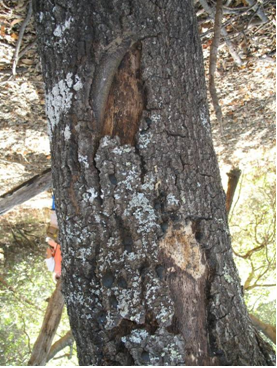
Sudden oak death canker development can be grouped into three general categories. Canker development is affected by the initial size of the canker and the host tree's reaction to infection.
Large cankers / susceptible reaction: Highly susceptible host trees develop large, rapidly expanding cankers. These may result from the merging of multiple cankers. Actively expanding cankers commonly show fresh bleeding around the edges. Beetles usually attack these cankers within a year of initial bleeding symptoms. Annulohypoxylon thouarsianum is evident within 1 to 2 years of initial bleeding. As the cankers expand, beetles and A. thouarsianum may extend beyond the canker margins, especially higher on the stem, into areas that are weakened or killed by the canker’s girdling effect.
Small cankers / resistant reaction: Many bleeding cankers (28-35% in one long-term study) become inactive within a year or two after bleeding is first seen (fig. 1-9). These cankers fail to expand and cease bleeding. They are not colonized by secondary agents and may become undetectable after one to several years. Small cankers (usually less than 10 cm across) are most likely to become inactive. Although individual cankers can become inactive, trees with inactive cankers can develop new cankers on other portions of the trunk if conditions become favorable for establishment of new infections.
Intermediate reaction: Many cankers in the moderate to large size class (>10 cm wide) are invaded by secondary organisms but eventually stop expanding and become largely inactive. Bark over the canker may become sunken and healthy callus tissue may develop at the edges of the canker (fig. 1-14). The dead bark dries out and shrinks, becoming cracked and sunken, and pieces may eventually fall off. Wood-boring insects and decay fungi may eventually degrade the wood beneath the canker. Old infections of this type are difficult to diagnose as SOD cankers.

Figure 1-14—Old Phytophthora ramorum canker on California black oak exhibiting an intermediate disease reaction. Note callus tissue at lower right margin of canker and Annulohypoxylon thouarsianum fruiting bodies on dead bark.